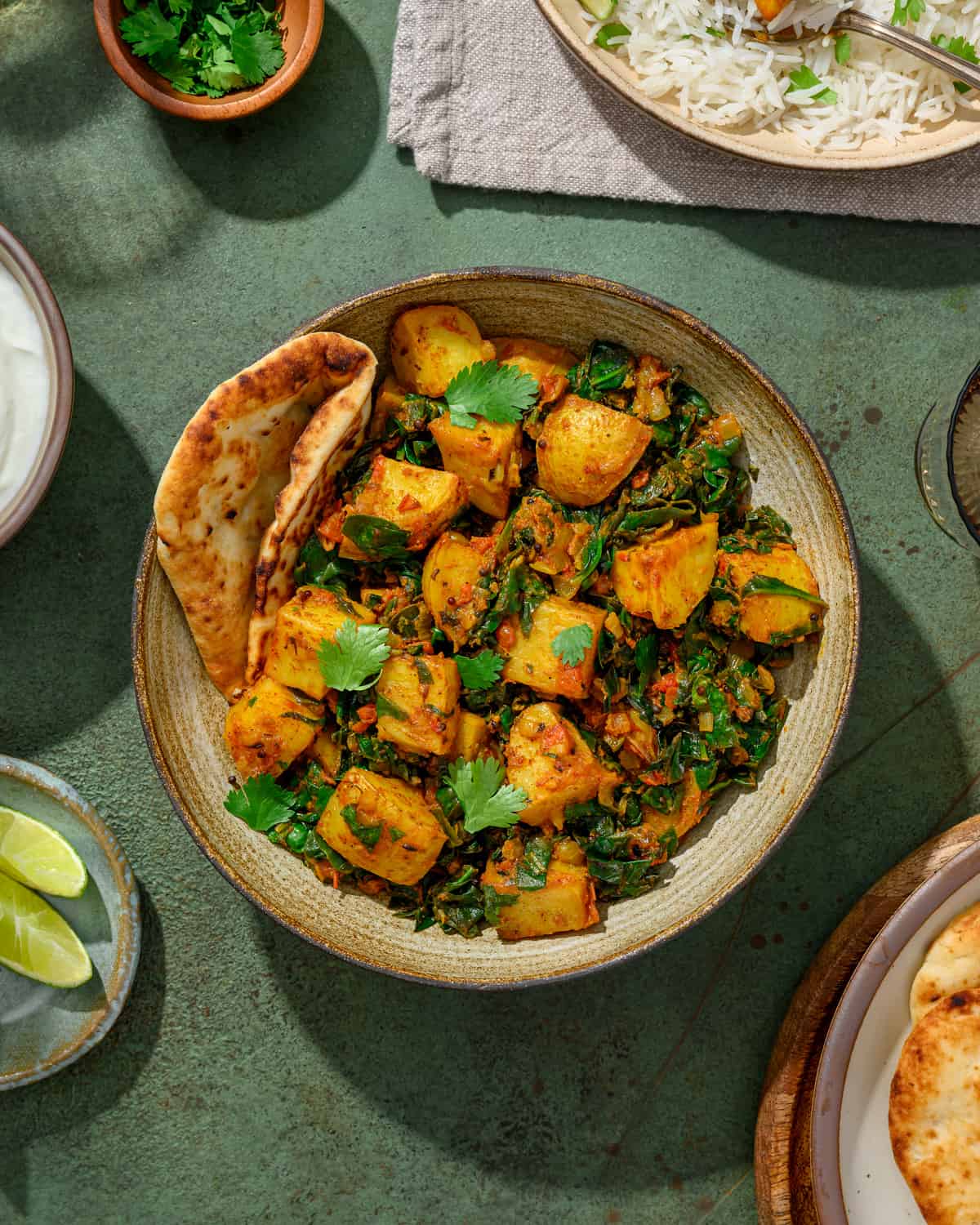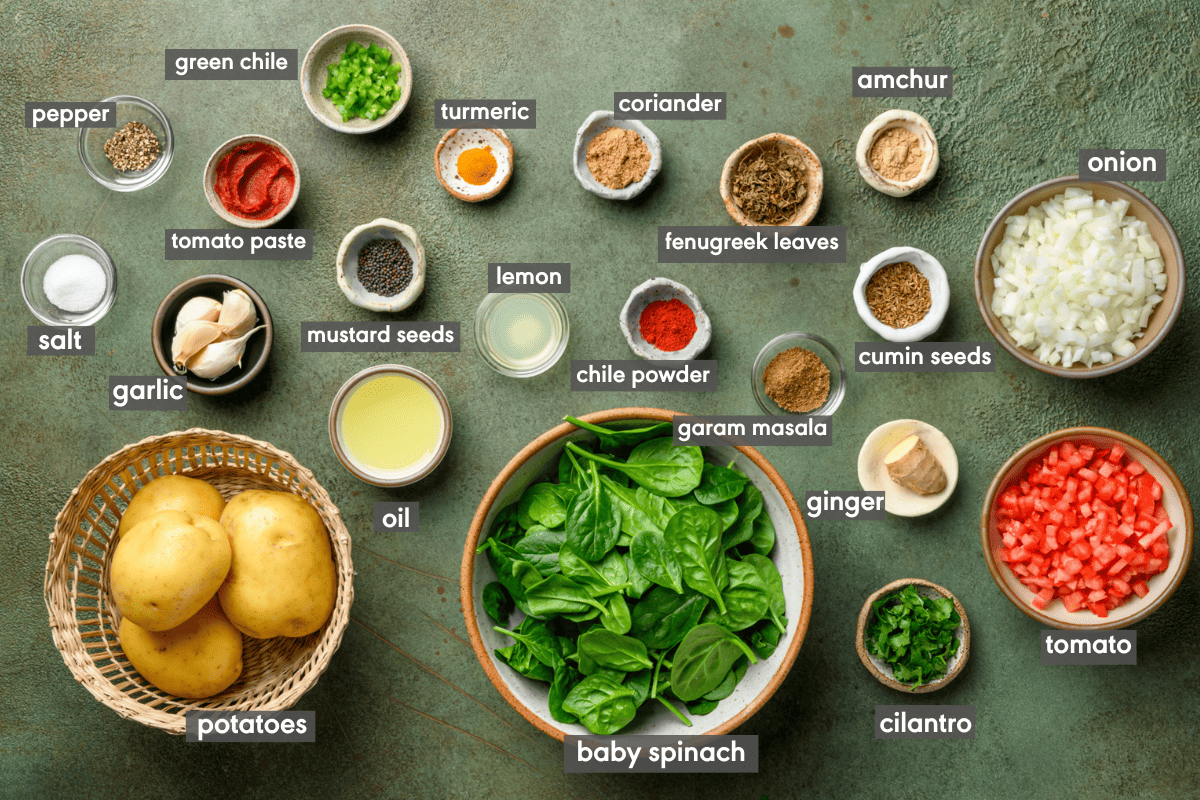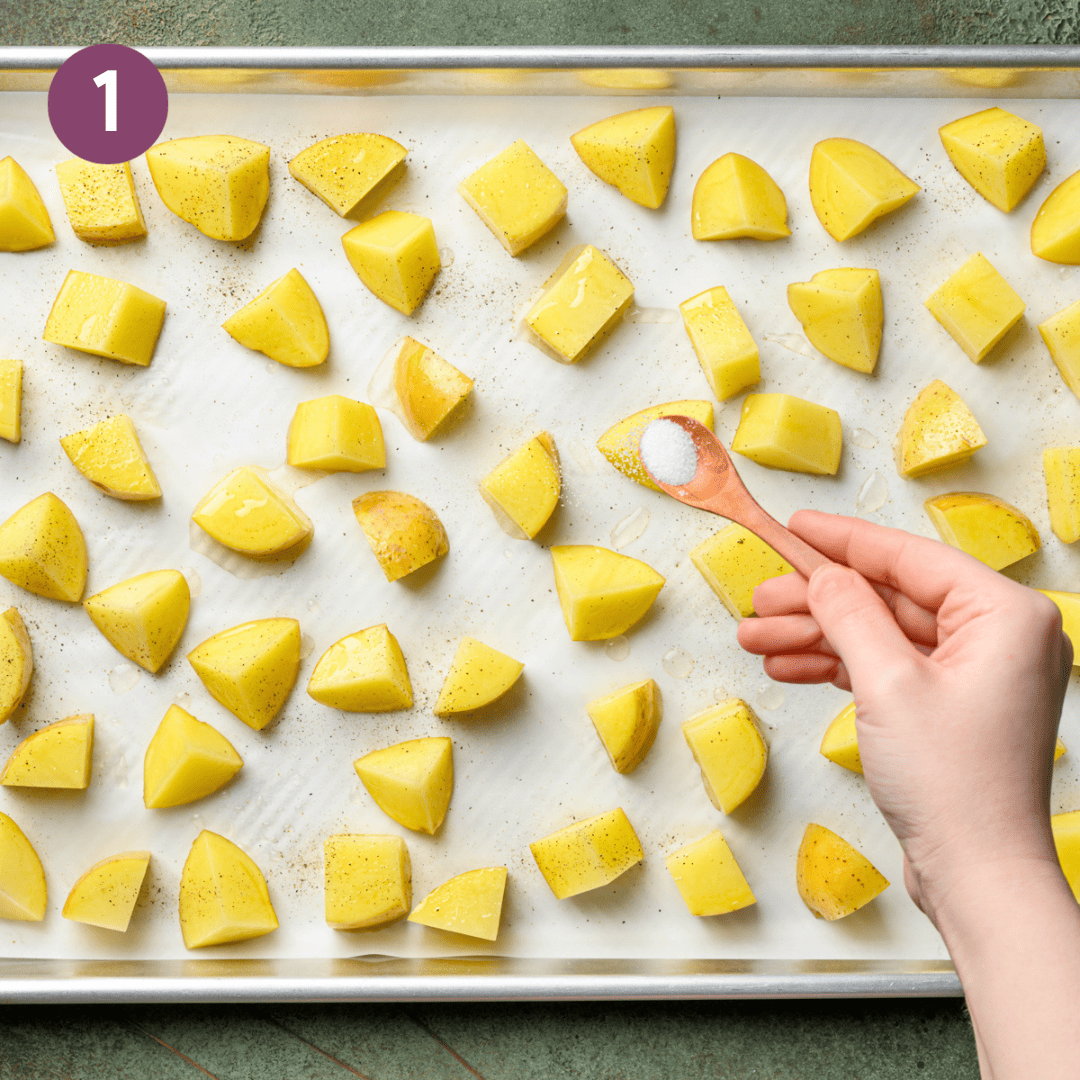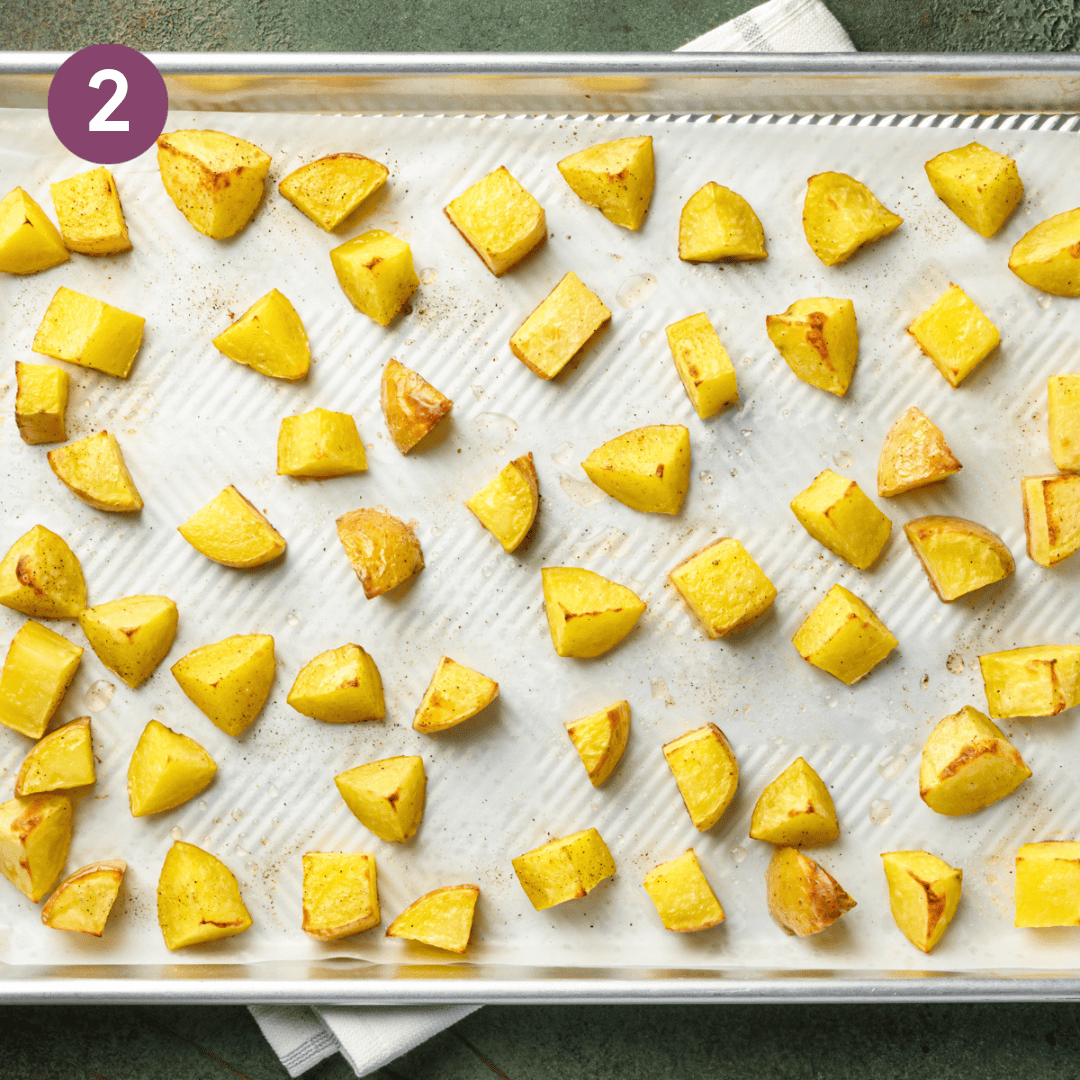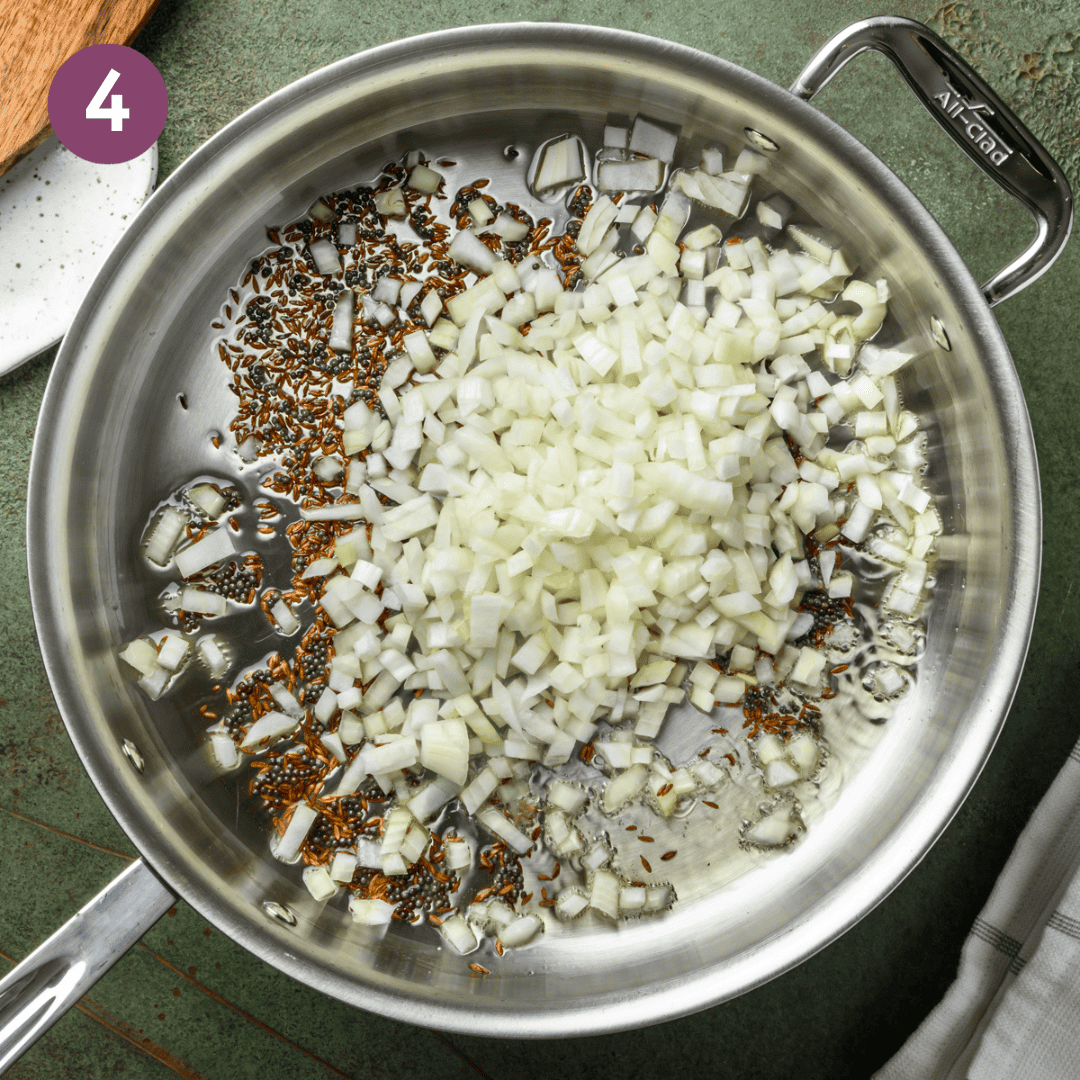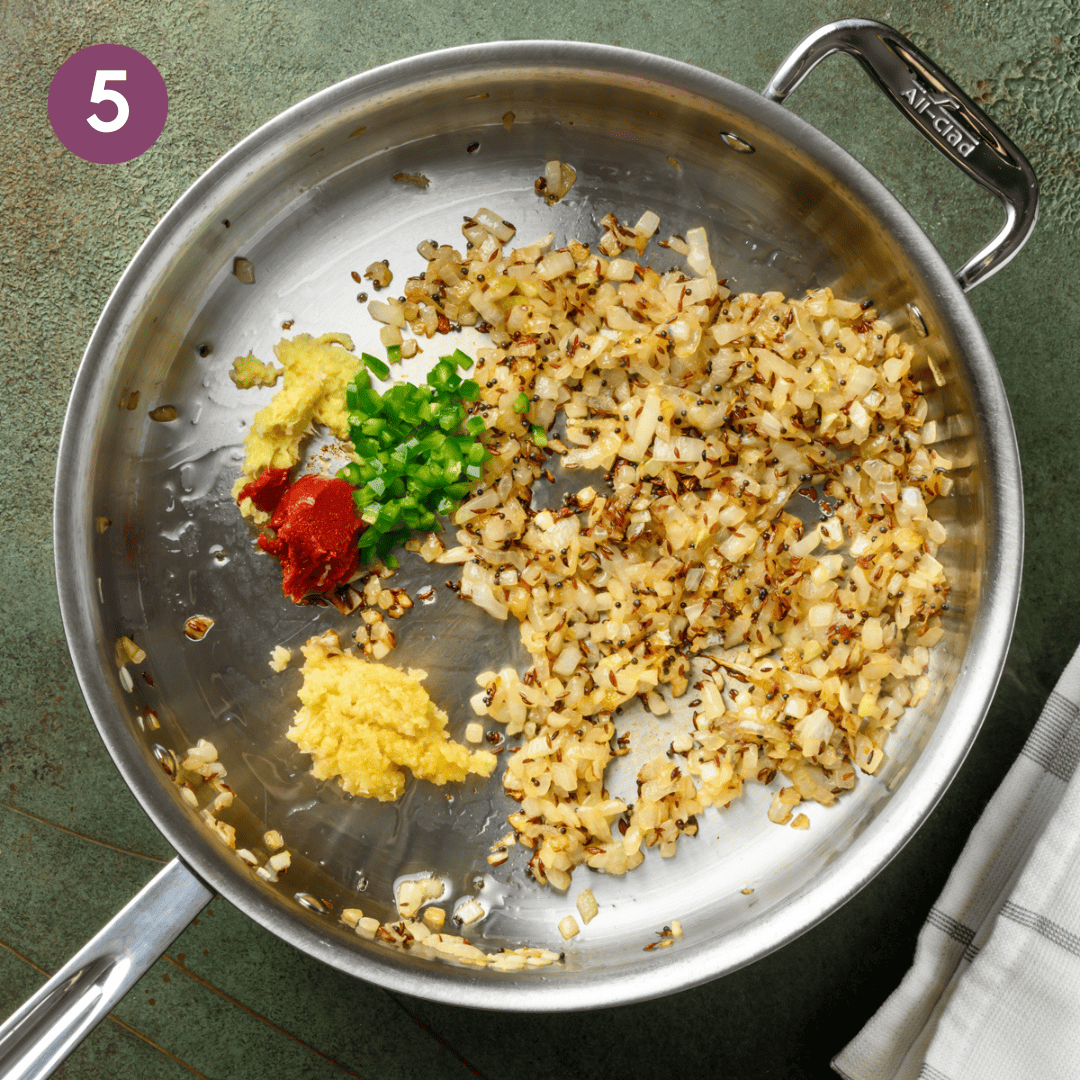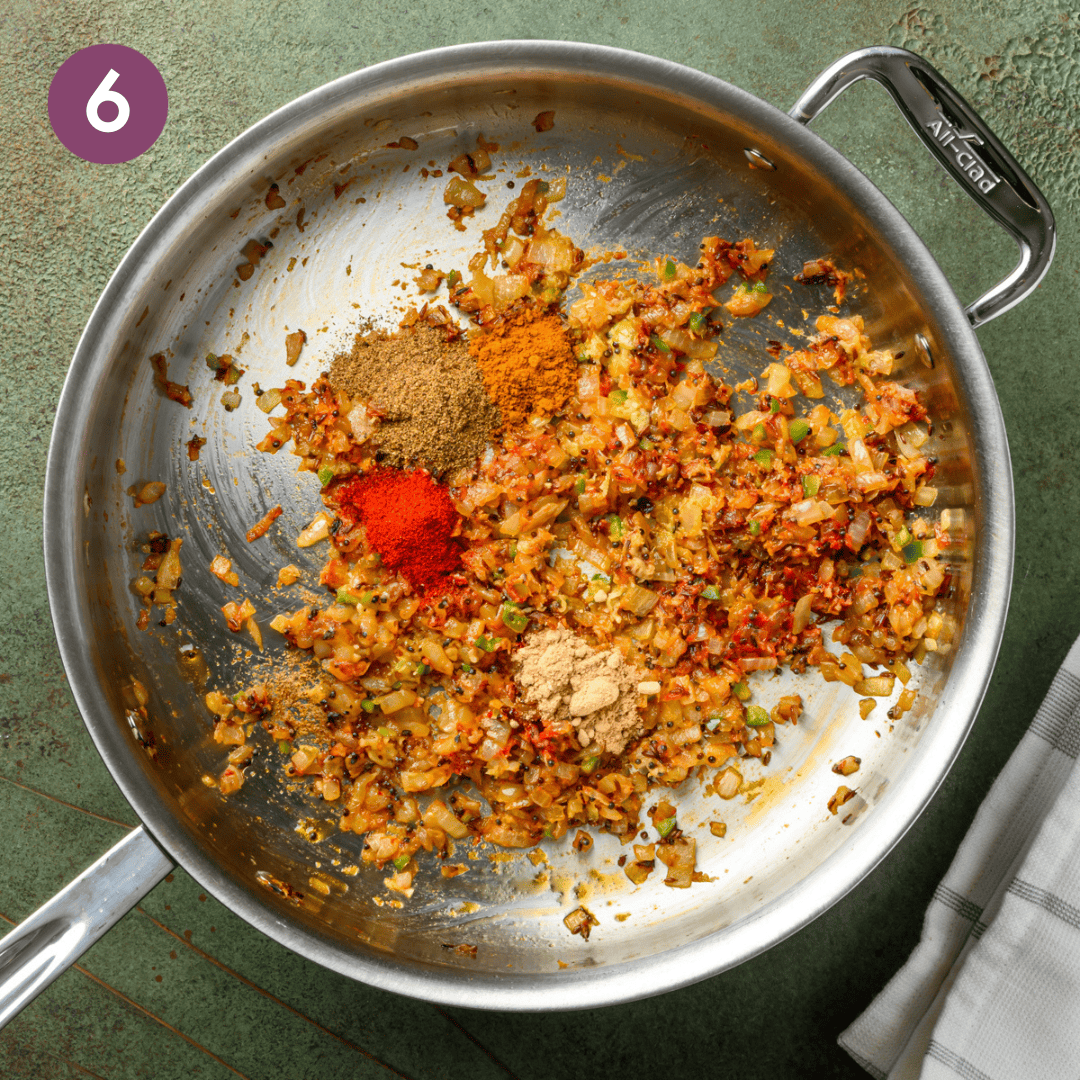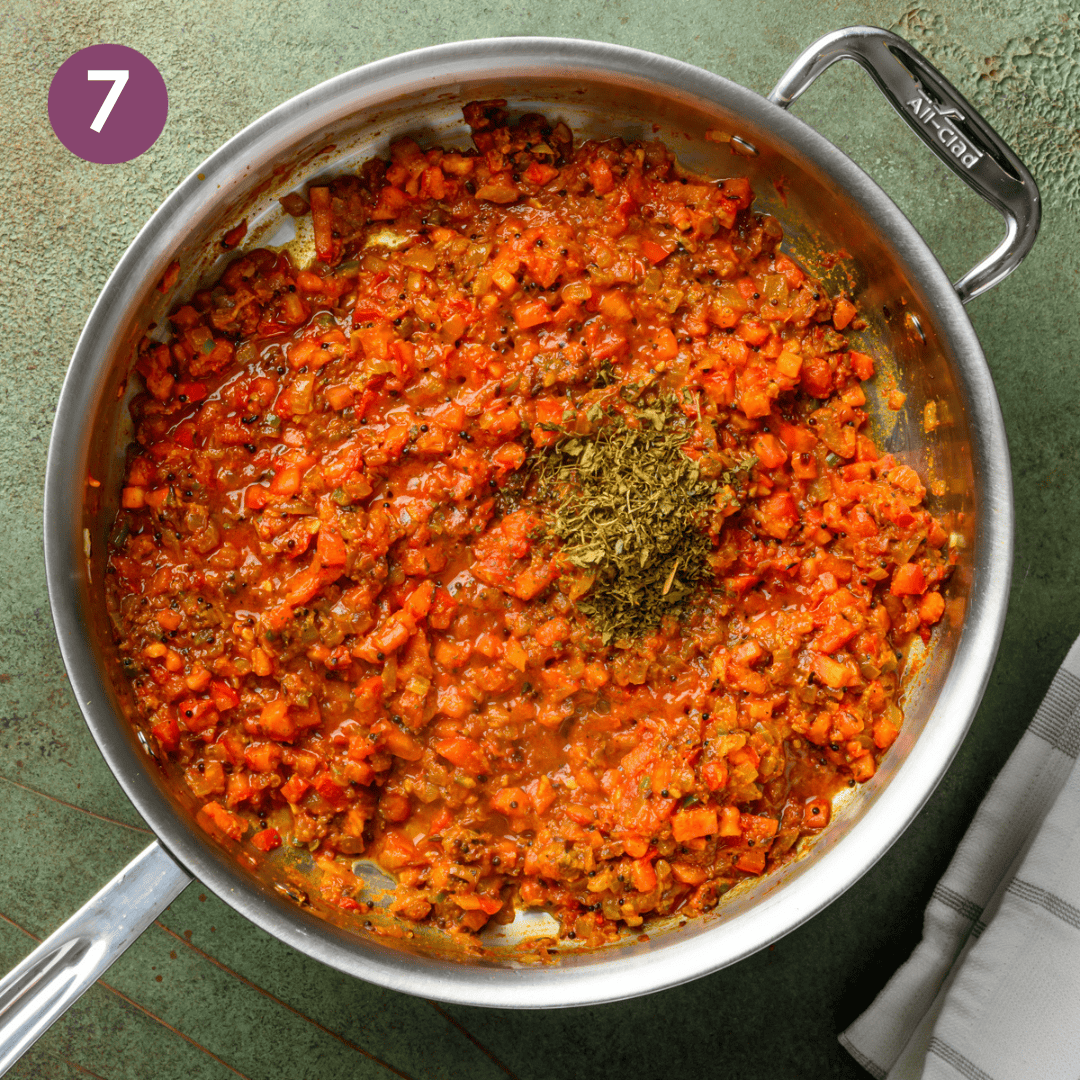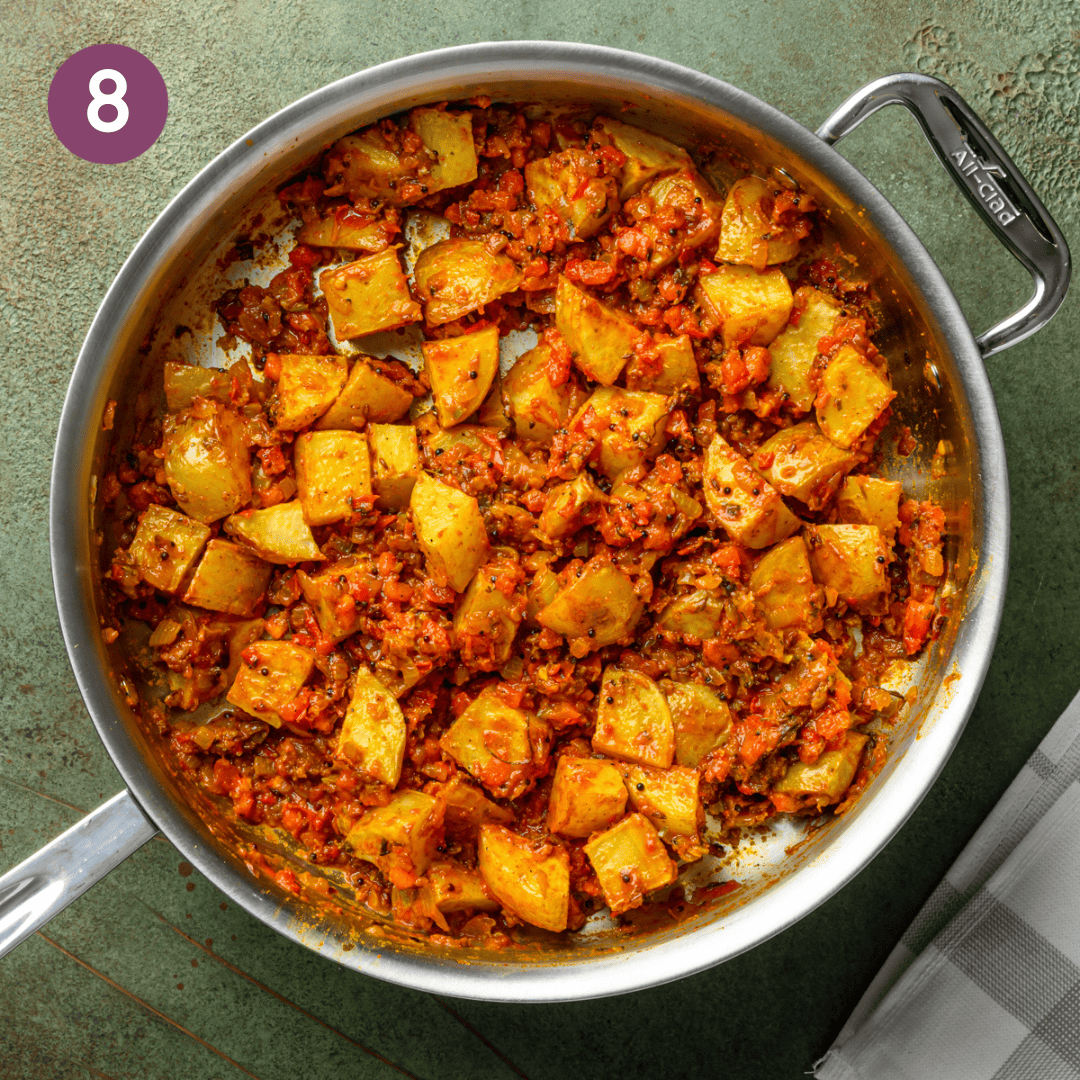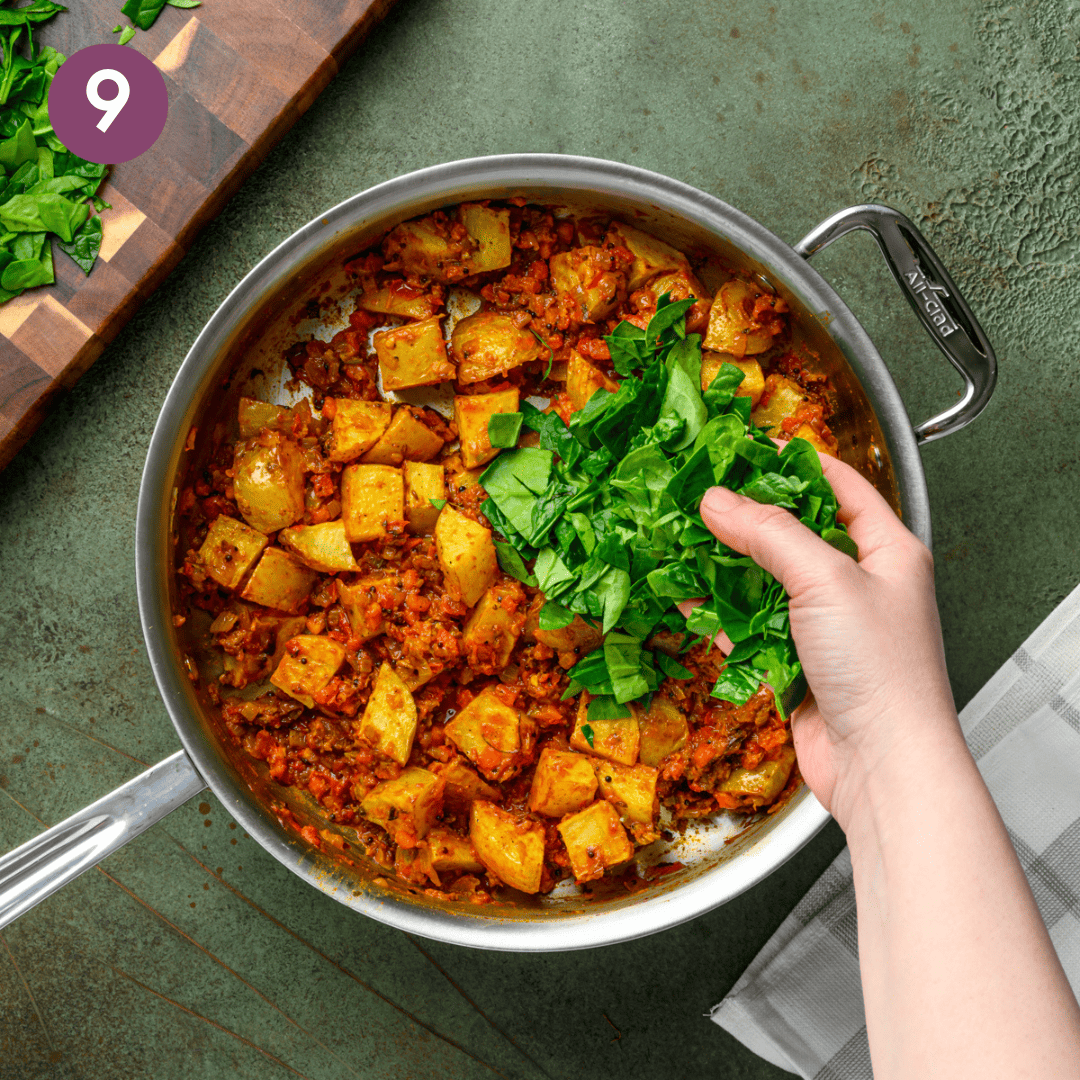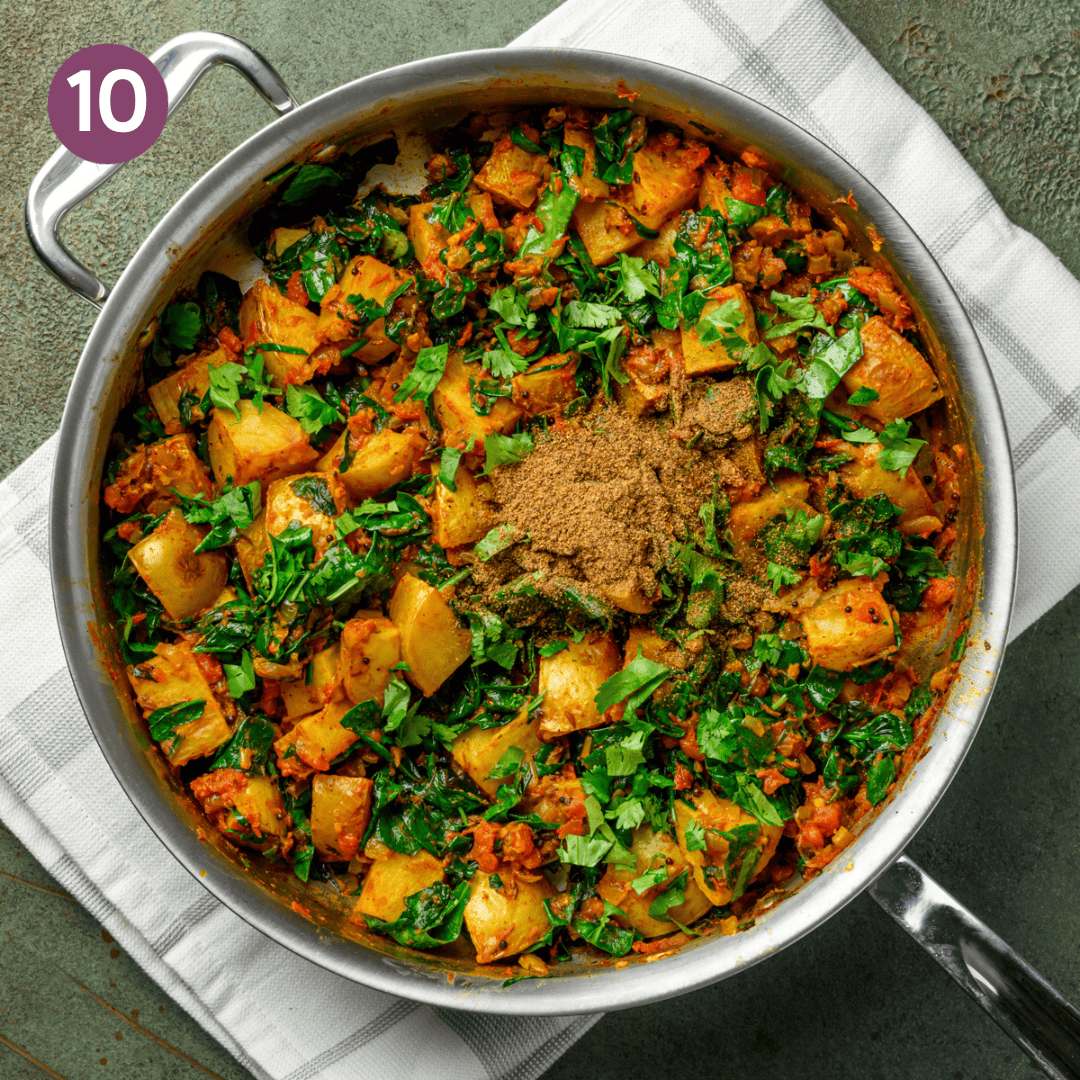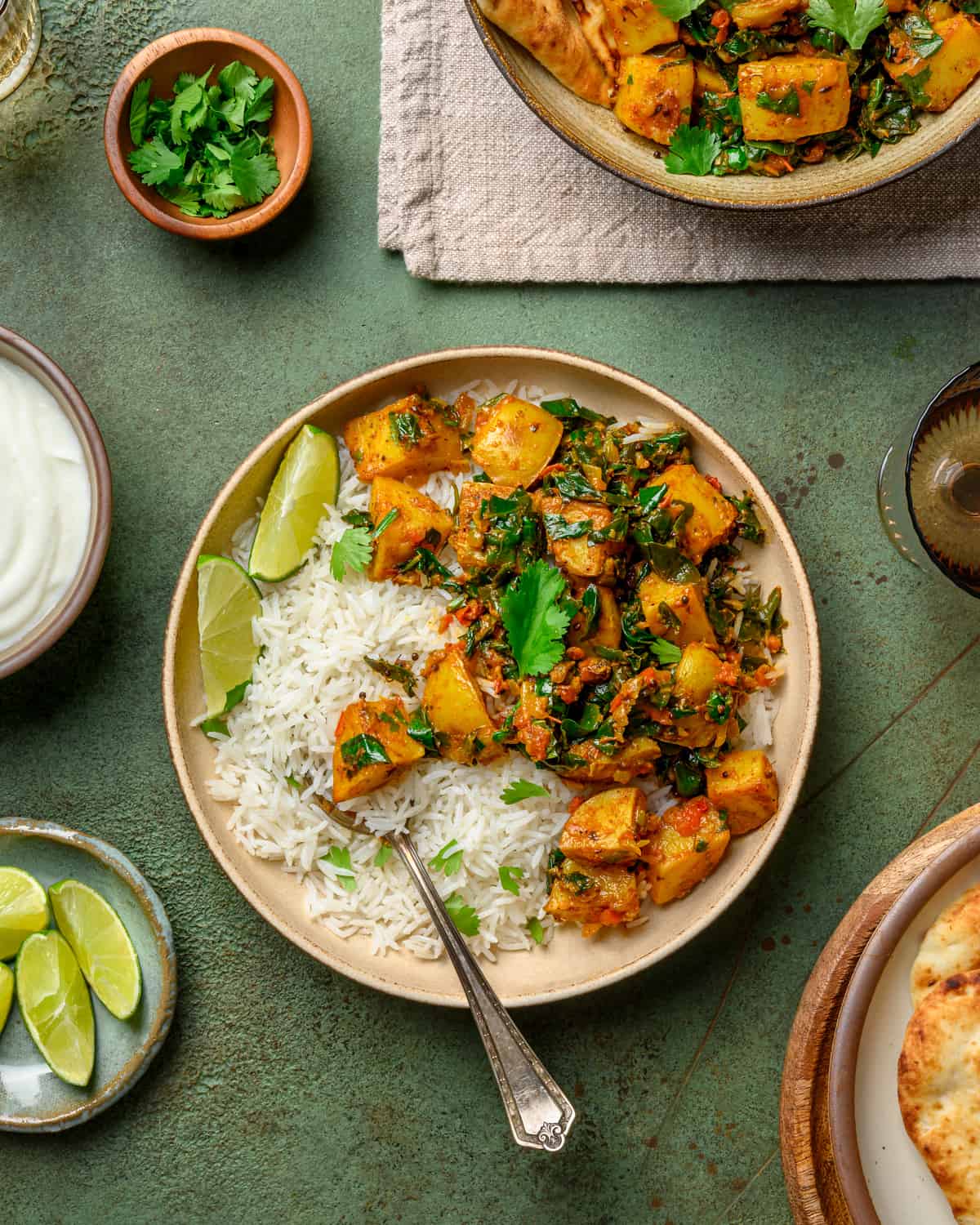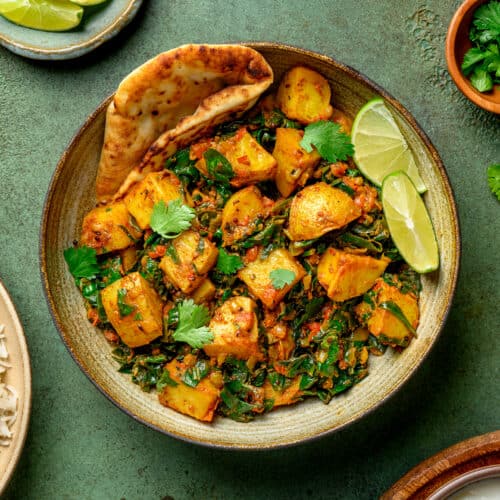Just like Aloo Gobi, saag aloo is a classic Indian dish that’s nourishing and filling enough to be served as a main or side dish. I stray a little ways away from the traditional version, though, which sautés and steams the potatoes. By roasting the potatoes instead, they take on the most indulgent buttery yet crisp texture that makes every bite of this spiced dish heavenly!
What is Saag Aloo?
Saag aloo is a popular Indian and Pakistani side dish made by frying potatoes (aloo) and leafy greens (saag) in spices and aromatics. It’s traditionally served as a side dish but is filling and comforting enough to enjoy as the main event. In India, saag doesn’t refer to just one type of leafy green. Instead, it can refer to various greens, such as mustard greens, fenugreek leaves, or spinach (also known as palak). Since some of these greens are hard to find in the U.S., I use baby spinach to ensure a quick and accessible dish, so you can also call it aloo palak (or palak aloo). And just like Aloo Gobi, there are dry versions of saag aloo and wet or “curry” versions of it. My recipe shows you how to make the dry version.
Why this recipe works
Streamlined method = mouthwatering results
Traditional saag aloo recipes steam-sauté the potatoes in the same pan as the masala. However, after extensively testing my Aloo Gobi recipe, I found that this method had me stirring for long periods of time only to be left with meh-flavored potatoes. They either didn’t cook all the way through or left some potatoes tender and others not. Instead, I opt for a nontraditional, albeit convenient method that resulted in mouthwatering potatoes: roasting. By roasting the potatoes in the oven, their hidden flavors are brought to the forefront while they also develop a gorgeous golden crust and tender-crisp texture. Oven roasting also means the potatoes don’t need to be flipped or tossed, so less babysitting for you! All of this extra time allows you to work on the second component of the dish: the masala.
The best Indian comfort food
Everyone I served this to has said something along the lines of, “This dish is like Indian restaurant comfort food!” A careful blend of Indian aromatics – onions, garlic, ginger, and green chiles – plus whole and ground spices deliver traditional bold Indian flavors that you’d typically find in Indian restaurants. Achieving this isn’t that complicated, either. You just need the right ingredients!
Indulgent yet wholesome
Can you believe that this recipe packs in a whopping 10 ounces (300g) of spinach?! All of that spinach loads this dish with properties that can boost your eye health, reduce your risk of cancer (specifically prostate and breast cancer), give you healthy skin, and much more. But aloo saag (or saag aloo, either is fine!) is so delicious and indulgent that you won’t even notice you’re eating something good for you. The ratio of indulgent creamy spiced potatoes with a buttery mouthfeel to nutrient-rich and silky spinach is simply perfect.
Ingredient notes
Potatoes
The star of the dish! I like making this spinach potato curry with Yukon Gold potatoes because they’re a little waxy and a little starchy, which gives them a creamy interior when roasted. Slicing them into medium-sized pieces (slightly less than 1” or 2.5 cm in size) helps them cook quickly and makes them the perfect bite size. Russet potatoes will also work if that’s all you can find. They’ll just be a little softer and a bit fluffier rather than creamy.
Baby spinach
Technically, you can make saag aloo with any type of leafy green you like, not just baby spinach. However, it’s my leafy green of choice because it requires no prep except for a quick chop (which you can do while the onions cook). More mature spinach leaves require you to cut off their thick stems. Plus, they take longer to cook, and sometimes have a bitter flavor that comes through in this quick cooking process.
Whole spices
The masala (the saucy blend of aromatics and spices) is essential to saag aloo (and a ton of other Indian recipes, really). It begins with whole cumin seeds and mustard seeds to build a powerful layer of flavor. Plus, the bouncy texture of the mustard seeds is delightful with the tender potatoes and spinach.
Classic Indian aromatics
This dish calls for some classic Indian aromatics, like onions, ginger, garlic, and green chiles. They start off the masala with a super flavorful baseline, while tomatoes add the necessary tang and very subtle sweetness. Substitute: I prefer to make this with fresh tomatoes but if they’re out of season, use an equivalent amount (8 oz / 230g) of canned diced or crushed tomatoes.
Ground spices
Most versions of saag aloo contain turmeric, coriander, and red chili powder, while some also contain two spices you might not be as familiar with: amchur powder and asafoetida (the latter is known as “hing” in Hindi). Amchur is a refreshingly tangy powder made from dried, unripe mangoes. Asafoetida is more funky (it smells strong!) and lends a quintessentially Indian flavor that is hard to describe in words (it’s actually a resin rather than a classic spice). Where to buy: I recommend taking a trip to your local Indian market to pick up amchur, asafoetida, and other ingredients for this recipe. Or, if you’re due for a spice restock, my favorite spice brand, Burlap & Barrel, sells a fantastic amchur powder grown on a family farm in the most famous mango-growing region of India; this is also a brand I like. For asafetida, this is the one my mom has used for years (affiliate links). Substitutions: No amchur? Add more lime or lemon juice at the end for tang. No asafoetida? Just omit it. Allergic to gluten? Most varieties of asafoetida contain small amounts of gluten, so omit if you’re allergic. If you don’t want to leave it out, the brand Pure Indian Foods has a GF option or you can order GF asafoetida online (affiliate link).
Finishing spices
I like to finish this dish with two more spices: garam masala and fenugreek leaves, AKA kasoori methi. Fenugreek leaves are quite special here, as they add a bold, savory, pungent flavor that can’t be replicated with anything else. I’ve listed fenugreek leaves as optional, but if you visit an Indian grocery store, I’d consider it a must-buy! Just like in my Tofu Tikka Masala and Malai Kofta, it adds that je ne sais quoi flavor you’d typically find in Indian restaurant dishes.
Step-by-step instructions
Lay the scrubbed and chopped potatoes on a lined baking sheet. Drizzle them with oil and season with salt and pepper. Spread them into a single layer. Roast the potatoes until they’re browned in spots and tender but not super soft (without flipping). Meanwhile, make the masala by heating the oil in a large, deep sauté pan or Dutch oven over medium-high heat. Once shimmering, add the cumin seeds and mustard seeds. Shake the pan and stir frequently. Once the seeds start to pop, add the asafetida (optional); stir constantly for 10 seconds (it will smell funky!). Reduce the heat and add the onions. Cook until golden brown and soft, deglazing the pan with a splash of water as needed to prevent the aromatics from sticking. Now add the garlic, ginger, serrano pepper, and tomato paste to the pan with the onions/aromatics. Cook for 1 to 2 minutes before stirring in the turmeric, coriander, amchur, chile powder, and black pepper. Add the tomatoes and use the juices to deglaze the pan. Cook until the tomatoes have fully softened and the masala is turning into a thick, saucy texture. Crush in the fenugreek leaves with your hands and toss to coat. Transfer the roasted potatoes to the pot with the masala. Toss to coat and stir frequently to prevent sticking. Turn up the heat and add some of the spinach to the pan. Cook the spinach until it wilts a bit, then add another batch. Repeat until all of the spinach is tender. Take the saag aloo off of the heat and stir in the garam masala, lemon juice, and cilantro. Season to taste with salt as needed. Enjoy!
Tips for making this recipe
Don’t shortcut the spices
The whole and ground spices make this dish, so I don’t recommend making too many shortcuts. If you have a local Indian grocery store, make a trip there, and you’ll find all of the spices you need to achieve the restaurant-worthy flavors. Bonus: The spices at Indian grocers are SO much more affordable than at standard grocery stores! And usually you’ll find an Indian shop owner who’ll be more than happy to help you find what you need.
Streamline with multitasking
As the potatoes roast, chop the onions, tomatoes, and other aromatics. While you wait for the onions to cook, chop the baby spinach. These multitasking strategies save you time and help you put this amazing dish together much quicker.
Chop finely and evenly
The more finely you dice the onions, the quicker they’ll soften and turn golden. The same goes for the tomatoes – once they’re finely chopped, the tomatoes will quickly soften and melt into the masala, yielding a saucy and rich texture without leaving any distinct tomato pieces behind.
Don’t skimp on the oil
How do you get yourself to eat a mountain of spinach without even realizing it? You add a little bit of richness! In this recipe that comes in the form of oil. It not only helps to release all of the fat-soluble flavors in the spices, it also gives the finish dish a slightly saucy, silky texture. I promise it will make you feel like you’re eating serious comfort food and not a mountain of spinach!
Give the ingredients room to breath
Make the masala in a deep sauté pan or Dutch oven. A large pot like this leaves plenty of room to cook all ten ounces of spinach in no time. Make sure the potatoes are spread in a single layer on the baking sheet, too. Overlapping will cause them to steam rather than crisp and become golden.
More classic Indian recipes
Baingan Bharta Dal Makhani Malai Kofta Instant Pot Chana Masala
Big Vegan Flavor
Techniques and 150 recipes to master vegan cooking.
